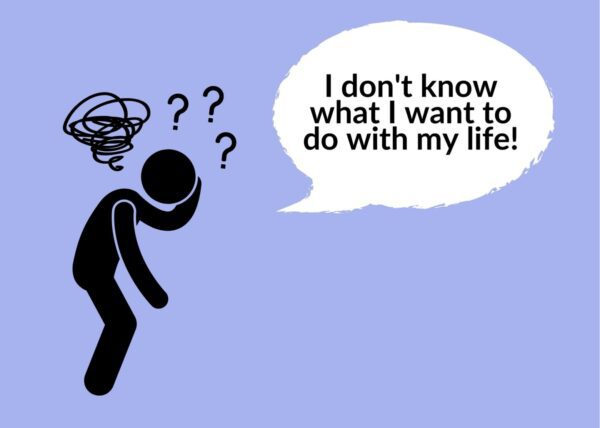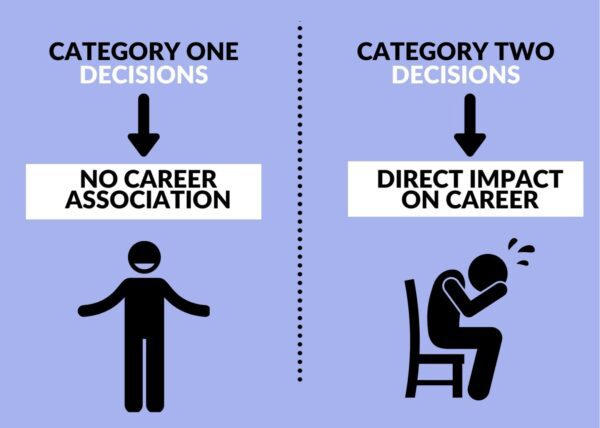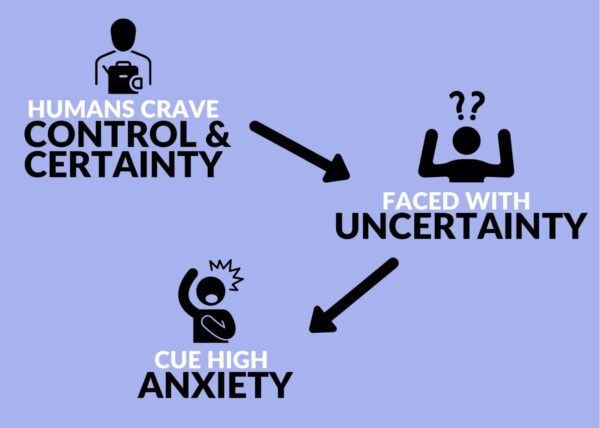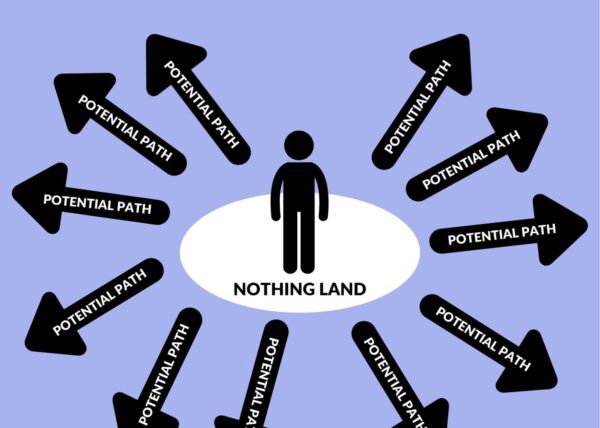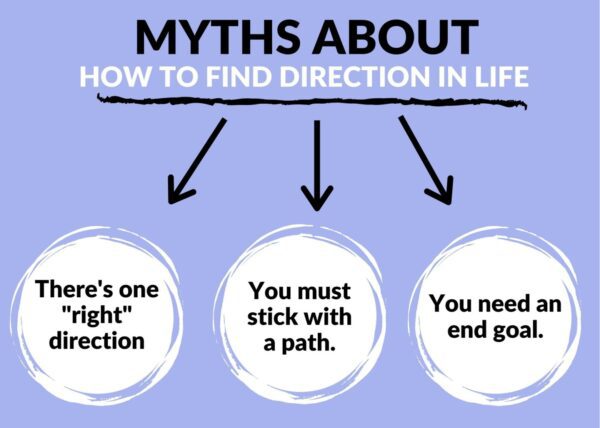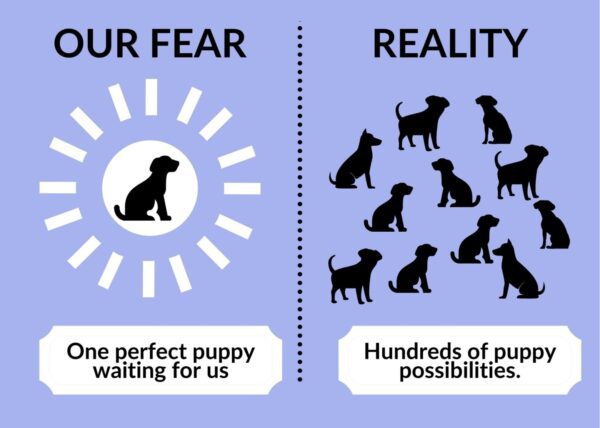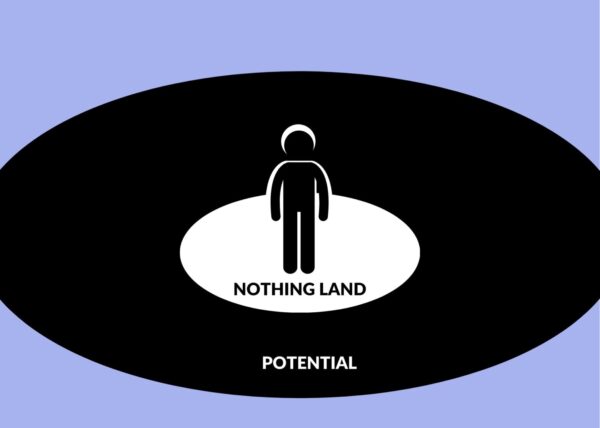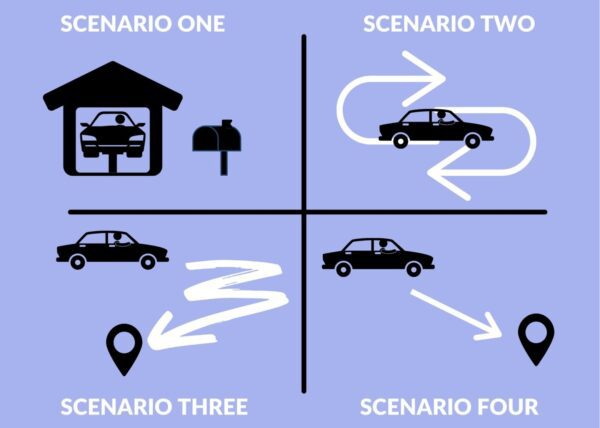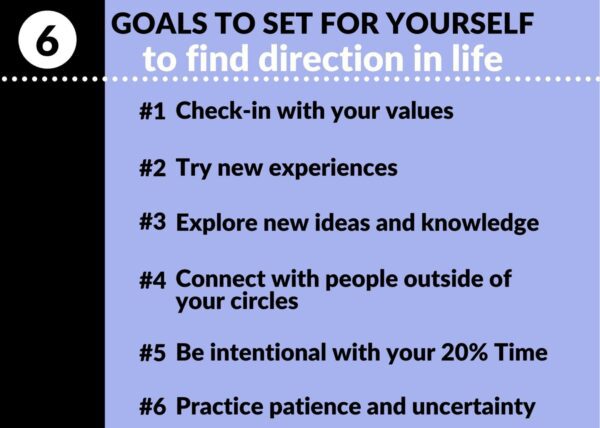A few weeks ago, my cousin Amy told me that she’s feeling lost. Typically a vibrant person, she’s felt apathetic about her work and disconnected from her colleagues. And, while it’s easy to blame the pandemic for this “low period,” I don’t think it’s the only cause of her unhappiness.
Sure, working remotely certainly takes a toll on our social and emotional health. But Amy’s primary complaint wasn’t from the Zoom calls or online conferences. Instead, she felt like she didn’t have a life direction.
It’s not the first time I’ve heard her say, “I just don’t know what I want to do with my life.” The same phrase came up a couple of years ago while she was working her first post-college job. And then again, periodically, throughout her job search in between. She’s jumped from ideas of graduate school, to different fields of work, to starting her own business.
Don’t mistake my tone; I’m not criticizing Amy’s attitude. Nor am I drafting a future commencement speech for recent college graduates (unless anyone out there wants to hire me…?). I’m highlighting a sentiment that we all regularly experience: the feeling that we can’t find direction in life.
Why is this such a common phenomenon? A few societal enemies, a couple of myths, and a lack of intentional steps – to name a few reasons. Fortunately, this post will tackle them all.
.
The Anxiety That Comes When Finding Direction in Your Life: How do I know if I’m on the right path in life?
When I reflect on my major life decisions, I can divide my reaction (and subsequent stress levels) into two categories. Category One encompasses decisions that I didn’t directly associate with a career path. And Category Two encompasses decisions that did.
Category One contained things like choosing a university or college minor. These decisions triggered less anxiety and were, on occasion, almost fun. Don’t get me wrong; these influential choices would affect my future career. But, for whatever reason, my brain didn’t amplify this correlation. The “need a job path now” alarm didn’t go off in my head.
And so, for Category One dilemmas, I didn’t end up in the fetal position in my bed, crying anxiously over a pro-con list that I wished would transform into a Magic Eightball.
This leads us to Category Two. Choosing a major, an internship, a job – anything that I associated with a step on my path to “Career.” Because, goal-oriented and driven person that I am, I felt I needed to find direction in life before getting on the path. After all, how would I know which direction to step first if I didn’t know where I was going?
Cue anxiety, stress, more pro-con lists, and more tears.
.
Humans Crave Certainty and Control
If you’ve ever taken a Buzzfeed quiz, you know the moment of instant pleasure that comes when you receive your results. It’s not that you necessarily agree with the answer – or even that you know what the answer means. (Sure, I guess a mocha chai latte does represent my spirit Starbucks drink!)
The pleasure comes because you have an immediate answer to lock in as certainty. You know something that you didn’t know before.
You see, humans crave certainty and control. When we don’t know something, our fight-or-flight mode gears up to protect us. Our brains perceive uncertainty as dangerous, and therefore, something to avoid at all costs.
The higher the stakes, the greater the anxiety.
Trying to decide what we want to do for a fifty-year-career? In a society that fixates on work satisfaction? Yeah, those are some pretty high stakes – and we feel pretty vulnerable not knowing an answer.
Whenever I faced the uncertainty of finding direction in life – a.k.a. Category Two Decisions – my primal defensive mechanisms kicked into gear. When this happened, danger replaced discovery. The need to have a choice overpowered the choosing process.
In my mind, I was standing in uncertain, dangerous, nothing land. A million possible paths extended around me in all directions. And I needed to find direction in life, choose a path, and get started ASAP.
One major problem… How the hell can I choose a path if I don’t know where it leads?
My “need to choose” leads us to a few of the most dangerous myths we fall victim to.
.
Three Myths Surrounding the Question: How do I find direction in my life?
.
Myth One: Finding Direction in Your Life Is About Finding One Direction
If you Google “Find direction in life,” you may notice one repeated word that I consider to be incredibly damaging. That word is “right.” Headline after headline encourages you to find the “right direction” in your life.
Why is this word so harmful?
Because if there’s a “right” direction, that implies a “wrong” direction. It encourages our brains to think in a binary – either/or, one or the other, this or that. Right or wrong.
Not only does this mindset amplify our anxiety, but it also narrows our perspective. It creates the visual that I struggled with. You’re standing in Nothing Circle with a million paths around you, and you have to choose the right one.
Here’s the truth. You need to stop asking, “How do I choose the right path in life?” There is no “right one,” as much as your control-craving brain wants there to be. Your future is not out there gleefully waiting for you, like a lost puppy, if only you choose correctly.
No, there are a million puppies out there that would be happy to come into your home. Yes, some dogs will be cuter than others, and some will poop on your carpet more than they should. But you’ll make it work – and if it doesn’t, you’ll adjust accordingly. There’s not solely one dog that will work.
Your future is the same way. There’s not one right future waiting for you. Your future doesn’t actually exist until you create it in the present.
.
Myth Two: Finding Direction in Your Life Is About Choosing a Path
Another myth emerges on this step-by-step walk. When we try to find direction in life, we imagine sticking to a specific path. Sure, it might swerve and curve, but we’re following it where it leads.
I want you to erase this image from your mind. Finding direction in your life is not a single path. You can jump around paths, move backward, skip over a couple of paths; heck, you can hop on a flight and fly to another path miles away.
In fact, it’s probably best not to imagine paths at all. You’re surrounded by “potential,” and, no matter which direction you go, there’s “potential.” And don’t forget you can move back to the “potential” you came from if you don’t like the new “potential” you stepped to.
.
Myth Three: Finding Direction in Your Life Needs an End Goal
If there was a photo of a person’s photo next to the description of “goal-oriented,” it’d be my face. I thrive on working toward something with a specific direction. For this reason, it’s super challenging for me to acknowledge – and break free – of this myth. I want to choose a direction with an end goal that I can commit myself to.
Because if I don’t have something to work toward, what am I doing?
This is so often where we get stuck in uncertainty. For some of us, we become paralyzed. For others, we become depressed. And for others, we choose a goal – any goal – just to work toward something. Even if it’s not what we want.
Don’t get me wrong; goals can be extremely useful and healthy. But they must be process goals, not end goals. That’s why I’m going to give you some goals to work toward today.
But first, let’s take a quick detour into a driving metaphor. (Don’t worry, you can take your Future Puppy with you for the ride.)
.
Shift Your Mindset on Finding Direction In Life When You’re Feeling Lost
Have I angered or freaked you out with these myths? Awesome, cool, always happy to help. But fear not, faithful readers, because I’m going somewhere with all this.
We can break free of these harmful myths and shift our mindset on how to find direction in life. Let me paint you an analogy to explain.
To start your day, you go outside and get into the driver’s seat of your car.
Scenario One:
You have no idea where to go, so you sit for hours in your driveway. When people walk by on the sidewalk, you ask, “Where should I go?” and receive funny looks in response. If you’re feeling particularly brave, you try taking a lap around the block before returning to your driveway.
Scenario Two:
You have no idea where to go, so you just start driving around aimlessly. You turn down streets that look interesting. At times, you pull over to try to figure out where you are. Other times, you ask someone for some suggestions or direction. As the drive continues, you begin to get a feel for the area and where you like driving best. Maybe you’ll end up back in your driveway, maybe you’ll end up somewhere new. Not always ideal, but at least you’re moving.
Scenario Three:
You have a general idea of where you want to go, know a few different ways to get there and trust that you’ll find your way. There’s not a specific time crunch, although you’d love to arrive before it gets dark. You meet a few people along the way that offer you directions – some of which you ignore, some that you gratefully take. On the way, you’ve got your podcast/music playlist cued up.
Scenario Four:
You have an address for your end destination, can plug it into your GPS, and plan to follow the turn-by-turn directions. There’s an ETA on your journey, and you hope to meet it (or, if you’re particularly over-achieving, beat it). If this means turning the music down so you can focus on your GPS, you’ll do so.
In all of these scenarios, imagine the “end destination” as your future goals. The “drive” represents that whole “living life” part.
.
Find Direction In Your Life: What we want versus what we need.
We want Scenario Four to be true because our control-craving brains find it the most comfortable. It feels good to know where we’re driving. But Scenario Four isn’t real, at least not in the “find direction in life” sense. Because even if you reach that destination, you’ll be faced with the same “Where should I go?” decision the next day you get in your car.
Obviously, Scenario One is the least practical option – yet many of us fall prey to this. Our anxiety flares up, and, rather than attempting a drive, we shut down. Furthermore, we look to others for answers about our lives that they can’t answer.
Our goal should be to find direction in life by falling somewhere between Scenario Two and Scenario Three. Some of us have more direction than others. But direction only comes from taking action.
It’s only with action that we can develop our self-awareness, which takes time and experience.
You can’t know where you want to go if you “haven’t been around the block” long enough to understand yourself more. Sure, living in Scenario Two forever might become challenging (not to mention cost you a lot of gas). But the more open you can be, even when you’re uncertain, the more you’ll begin to create direction in your life.
.
Steps to Help You Find Direction in Your Life: Set Better Goals
If you’re a goal-oriented person like me, you want to feel like you’re doing something to move forward. Even if you’re not obsessed with goals, you still probably want to feel movement rather than directionless. Remember, driving around and getting lost will teach you more than staying in your driveway.
That’s why I created this list of six steps that will help you find direction in life. Make them your goals, every day and every week. By focusing on them in the present, you will begin to find direction in your future.
-
Check-in with your values
Our core values are the principles that guide our choices on a daily and life-long basis. Life is complicated, so it doesn’t make sense to establish hard-and-fast rules. Similarly, it doesn’t serve us to cling to one right choice to make. That’s what having values is crucial in navigating the complexities of life. Discovering your values – and learning how to live your values – should be the driving force as you find direction in life. Your values can serve as guideposts in the “potential” land you’ll dance around in.
Read more:
- How to Discover Your Core Values
- How to Be True to Yourself: The Hidden Truth We Need to Embrace
- How to Define Your Personal Philosophy
.
-
Try new experiences
Our brains thrive on novelty. Every time we experience something new, we expand our brain’s neural pathways and increase our ability to make connections. We also forge opportunities to learn more about ourselves. No matter how hard we try, we can’t find a new direction in life if we go back to the same repeated situations. We need new evidence – forged by new experiences – to begin learning what we find meaningful.
Read more:
- How to Face Your Fears: 7 Steps to Overcome Fears
- Doing Versus Being: How to Escape Our Productivity Obsession
.
-
Explore new ideas and knowledge
Another way to open up your brain is to explore new ideas and knowledge. Remember the joy and curiosity you experienced as a young child? Try to tap back into that curiosity. The more ideas, information, and cultures we expose ourselves to, the more we can make connections and unlock our creativity. Our worlds quite literally expand. In this expansion, you’ll be surprised by how finding direction in life can transform from a scary, limited decision to an exciting, open world of possibilities. Make it a goal to keep learning new things, whether in books, podcasts, videos, or classes!
Read more:
.
-
Connect with people outside of your circles
Many of us spend the majority of our time interacting with the same few circles of people. Whether it’s at work, at home, or in social settings, we talk with the people we know. These relationships are crucial, no doubt, but they don’t always give us new insight or perspective. Finding direction in life thrives on exploring new doors and opportunities. How can you connect with people outside of your circles? Make it your goal to connect with more people, and challenge yourself to go beyond surface-level conversation. Imagine the insight you can learn from talking with people from all different walks of life.
Read more:
- 8 Steps to Create a Sense of Belonging in Life
- 5 Types of Relationships You Need In Life to Be Happy
.
-
Be intentional with your 20% Time
The average human spends about 7-8 hours per day sleeping and 9-10 hours working and commuting. You can add on a couple of hours for chores and errands. That leaves about 20% of your total waking hours free and open. That’s ⅕ of your day, and added up over time, becomes ⅕ of your life. Too often, we expect to find direction in life during our working hours. In reality, it’s in our free time that we’ll make new discoveries and learn what gives us purpose. Be intentional with your 20% Time and fill it in meaningful activities. For some, you might find what gives you purpose in your 20% Time can correlate to larger life goals. For others, your 20% Time might be filled with enough meaning to give you overall life direction.
Read more:
- Asking the Right Questions: How to Ask Questions the Right Way
- Design Your Environment for Success: 6 Life-Changing Steps
.
-
Practice patience and uncertainty
I know, hearing “patience” as a strategy to find direction and move forward might feel counterintuitive. But it’s true, and it’s crucial in your ability to discover yourself. Your answers will not come in a quick Buzzfeed survey or a brief trial run, no matter how much you want them to. Answers come in time through experience and growth. When you practice patience, you have to turn down the “need to find out now!” desire that we humans have. That means living in uncertainty, even if it feels uncomfortable or vulnerable. However, don’t mistake patience with fear. Not doing something because you’re scared doesn’t serve you. Doing new things and exploring new ideas are necessary to discovery, even if the answers don’t come right away.
You also can practice patience and uncertainty when searching for jobs. Rather than feeling anxiety over needing to find the perfect result (and feeling crushed when you can’t), try to lean into the exploration of the searches. What’s out there? What strikes you as interesting? By patiently checking in with yourself as you search, you’ll learn more than you might expect.
Read more:
- How to Get Comfortable Being Uncomfortable: Lean Into Discomfort
- Why Self-Awareness Is Important: Recognize What You Can Control
.
Conclusion: Find Direction in Life When You Don’t Have One
Feeling lost and directionless is never fun. Yet far too often, many of us feel stuck, paralyzed with choices, or lacking the answers we need. We thrive with certainty and control. As a result, not having these two elements sends us into fits of anxiety and unhappiness.
Another reason we’re feeling these negative emotions is that we’ve fallen victim to the societal myths about finding direction in life. These myths include:
- Finding Direction in Your Life Is About Finding One Direction
- Finding Direction in Your Life Is About Choosing a Path
- Finding Direction in Your Life Needs an End Goal
We should look at finding direction in life like a never-ending journey. Rather than setting harmful and unrealistic end goals, we should commit to goals in the present.
Six steps to find direction in life include:
- Check-in with your values
- Try new experiences
- Explore new ideas and knowledge
- Connect with people outside of your circles
- Be intentional with your 20% Time
- Practice patience and uncertainty


